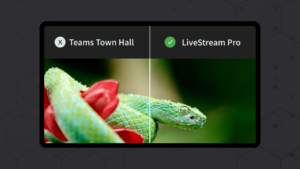Introduction: What if your videos created themselves?
Videos are among the most powerful formats in digital communication. But they are also seen as time-consuming, expensive, and technically demanding. Many companies shy away from the effort—or struggle with overloaded teams, tight budgets, and steep learning curves.
But the rules of the game have long since changed.
Artificial intelligence can now take over tasks that used to require multiple tools, expert knowledge, or external service providers. Automatic subtitles, multilingual versions, accurate transcriptions, voice-overs—all of this is now possible within minutes. Right in your browser. No prior knowledge needed.
In this article, you’ll learn how to automate five key steps of video production with AI. Each of these processes saves time, simplifies workflows, and opens up new possibilities for your video strategy.
If you’re looking to get more out of your videos—without having to invest more—keep reading.
Why AI is a turning point in video production right now
For a long time, artificial intelligence in video production was seen as a promise for the future. Today, it’s a reality—one that doesn’t just affect tech enthusiasts, but has very real impacts on the daily work of marketing, communications, and IT teams.

Modern video AI can recognize speech, automatically transcribe and translate it. It analyzes content, identifies key scenes, suggests edit points, generates text overlays, and even creates realistic-sounding voiceovers. And all of this doesn’t happen in a research lab—it’s available right now in tools you can start using immediately.
But the real turning point isn’t the technology itself—it’s the accessibility. What used to require specialized software and technical expertise can now be done with just a few clicks. No agency, no developer, no training video needed. The interfaces are so intuitive that even complex tasks like subtitling or voice-over can be done in just minutes.
For companies, this means: producing high-quality videos is no longer a question of budget—it’s a matter of choice. Those who embrace AI today gain freedom, lower barriers, and speed up workflows—without compromising on quality.
5 processes you can already automate today
The following five processes are among the most common and most resource-intensive steps in video production. Today, they can be automated in no time with the help of AI—without an external team, without training, and without switching between tools. Each one saves valuable time and frees you up for more creative and strategic work.
Automatic subtitling and transcription
Whether on social media, in the intranet, or in a customer portal—many users watch videos without sound. Subtitles are no longer a nice-to–have, but a standard. They improve reach, clarity, and discoverability of your content, and in many cases, they are the first step toward accessible communication.

Artificial intelligence can automatically recognize spoken language and convert it into written text. It not only captures the content accurately but also sets the timing precisely. The result: cleanly synchronized subtitles that can be embedded directly into the video or provided separately.
Complete transcripts—for example, for documentation, meeting records, or content repurposing—can also be generated with just a few clicks. Tedious manual typing is a thing of the past.
This process is especially helpful in the following scenarios:
- When publishing video content in multilingual or international contexts
- For internal training formats and onboarding videos
- To meet legal accessibility requirements
What used to take hours or even days can now be automated—reliably, at scale, and with surprisingly high accuracy.
Translations and multilingual content
Anyone using video content in an international context knows the dilemma: every additional language means extra effort for translation, localization, and possibly voice-over. At the same time, users today rightfully expect to consume content in their own language.

Artificial intelligence offers a direct solution here. It can translate automatically generated subtitles into other languages—often within seconds and with impressive quality. The translations are context-aware, stylistically flexible, and can even be combined with synthetic voiceovers if desired.
This means that a German-language video can quickly be published in English, French, or Spanish—with accurately timed subtitles and a natural-sounding voice-over version. And all of this can be done without hiring an external translation agency or booking a recording studio.
This process is especially valuable:
- For global companies with international teams or customers
- For recurring formats like product updates, training videos, or CEO statements
- For internal communications that need to reach employees across multiple international locations
What used to take weeks can now be done in a single workday. With AI, linguistic diversity is no longer a challenge—it’s a competitive advantage.
Text creation for descriptions, captions, and teasers
A good video alone isn’t enough. To be discovered, understood, and clicked, it needs the right context: a title, description, teaser text, social media captions, or accompanying emails. In practice, these supporting texts are often a bottleneck. They take time, are hard to standardize, and tie up creative resources that are needed elsewhere.

Artificial intelligence can take over these tasks in a targeted way. Based on the video content or an automatically generated transcript, it can suggest descriptions, catchy headlines, hashtags, or personalized social media captions. Structured metadata such as tags, categories, or content summaries can also be generated automatically—improving discoverability on both internal and external platforms.
AI can also generate alt texts for embedded videos—an important aspect of digital accessibility. These alternative descriptions support people with visual impairments and also enhance the semantic quality of websites and intranets.
For email campaigns, landing pages, or internal news articles, AI can create relevant, well-structured, and ready-to-use text within minutes. The generated content can serve either as a finished product or as a high-quality draft for editorial refinement.
Typical use cases:
- Uploading videos to internal platforms, media libraries, or newsletter formats
- Publishing on social networks with fitting captions and link texts
- SEO optimization through well-written video descriptions
The benefits are clear: less manual work, more consistency, and significantly shorter time-to-publish—even when handling large volumes of video content.
Rough cuts and highlight detection
The rough cut is often the most time-consuming part of video production. Anyone who has ever recorded a long interview, event, or internal meeting knows: the real art lies not in the recording, but in the reduction. What’s truly relevant? Which moments resonate, explain, or persuade?

Artificial intelligence can provide tremendous support at exactly this stage. Modern systems analyze video content and automatically detect relevant scenes, speech segments, visual transitions, or emotional highlights. This turns your raw, unedited footage into a structured draft within minutes—including automatic chapter markers or preview clips.
This feature is especially helpful when:
- You regularly produce long-form content, such as keynotes, interviews, or webinars
- You need short highlight versions for social media or internal teasers
- You want to repurpose content or re-edit it into new formats
Another advantage: AI doesn’t “think” linearly. It can generate multiple editing suggestions, highlight different focal points, or automatically create variations—for example, tailored to different audiences or platforms. This allows for maximum content repurposing with minimal effort.
Instead of scrubbing through hours of footage, teams get instantly usable results—while still maintaining creative control over the final polish.
Voice-over with AI-generated voices
Professional voiceovers are a real quality factor in video production—but also a challenge. Scheduling, studio recordings, revision rounds, and last but not least, the costs, make traditional voice-over processes time-consuming and inflexible. This is especially true when multiple languages or short production cycles are involved.

AI can drastically reduce this effort. Intelligent text-to-speech systems now produce synthetic voiceovers that sound surprisingly natural—including emphasis, pauses, and emotional tone. You simply enter the desired text, select a voice, and the finished voice-over is ready within seconds.
Depending on the use case, you can choose from different styles, genders, and language variants. The generated audio track can be embedded directly into videos or edited further if needed.
Typical use cases:
- Explainer videos, product demos, or tutorials that require regular updates
- Multilingual versions of CEO statements or internal announcements
- E-learning formats where reusability and consistency are key
AI also enables A/B testing with different voices or tones—without the need for new recording sessions.
The big advantage: the voice is always available, works around the clock, and delivers consistent results. This gives companies more independence, faster turnaround times, and maximum flexibility in content production.
What you should still do yourself—even with AI
Artificial intelligence can simplify, accelerate, and enhance many tasks in the video production process. But as powerful as the technology is, it doesn’t replace people—it expands their capabilities. To fully unlock its potential, it’s important to understand where the limits lie and where human judgment, creativity, and sensitivity remain essential.

Editorial decisions, content prioritization, and audience targeting are—and will remain—tasks that require context, experience, and a feel for language and impact. Even though AI can formulate texts or suggest scenes, it’s the communication team that ultimately decides which message should take center stage, what tone is appropriate, and which visual language aligns with the brand.
Equally important: quality control. AI can make automated suggestions, but it doesn’t know your corporate language or communication strategy in detail. A human review ensures consistency, credibility, and accuracy—especially for sensitive or high-profile content.
And finally: creativity cannot be delegated. New ideas, unique perspectives, or emotional storytelling don’t come from algorithms. They emerge from a blend of experience, intuition, and the courage to experiment.
That doesn’t mean AI and creativity are at odds—on the contrary. When used correctly, artificial intelligence creates space for exactly those creative contributions. It takes care of routine tasks, provides inspiration, structures complex workflows, and gives your team more time to focus on what truly matters: meaningful content that makes an impact.
Conclusion: Those who use AI now don’t just produce videos faster—but better
The demands on video communication are growing—in quantity, quality, and speed. At the same time, many teams are under increasing pressure to do more with less. Artificial intelligence provides real value right at this intersection. It automates tasks that used to be time- and resource-intensive, making professional video production more accessible to more people.
The five processes we’ve highlighted—subtitling, translation, text creation, rough cuts, and voice-overs—demonstrate how directly, concretely, and practically AI can already be applied today. No technical barriers, no lengthy training, no need for external service providers.
Those who get started early benefit twice: from faster workflows and from a strategic advantage over competitors who are still hesitating. Because the transformation is already underway—and those who actively shape it gain greater reach, better communication outcomes, and more efficient use of resources.
With AI, you no longer have to do everything yourself—but you stay in control.
Want to see how these processes work in practice?
Then meet our Video AI Assistant and discover how easy video production can be today.
AI-powered Video Optimization




















